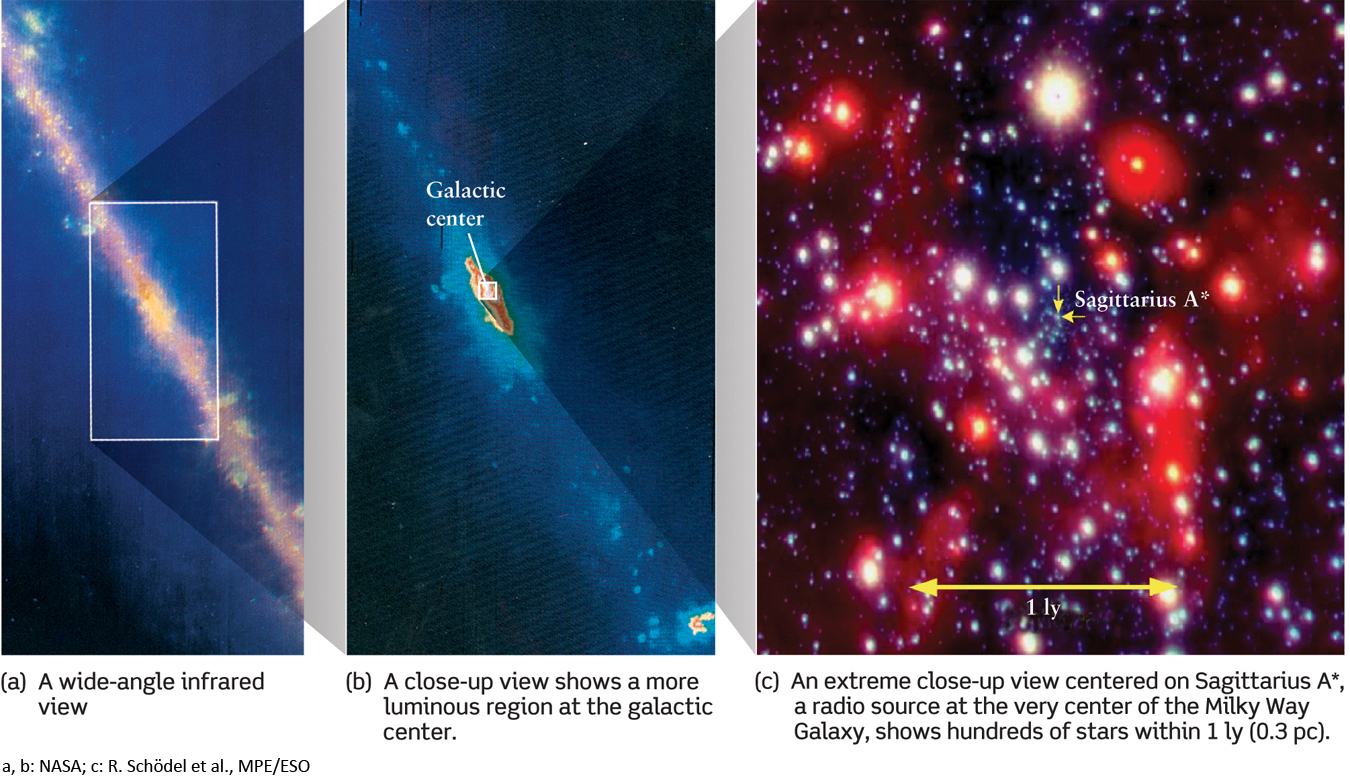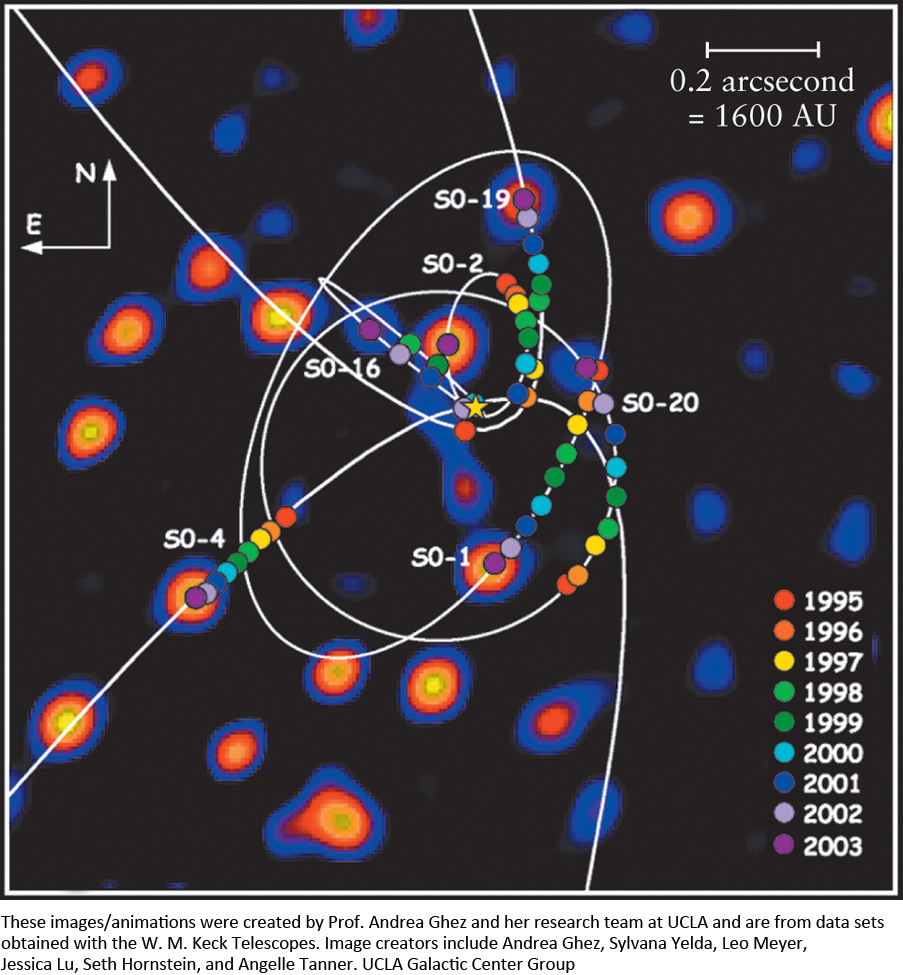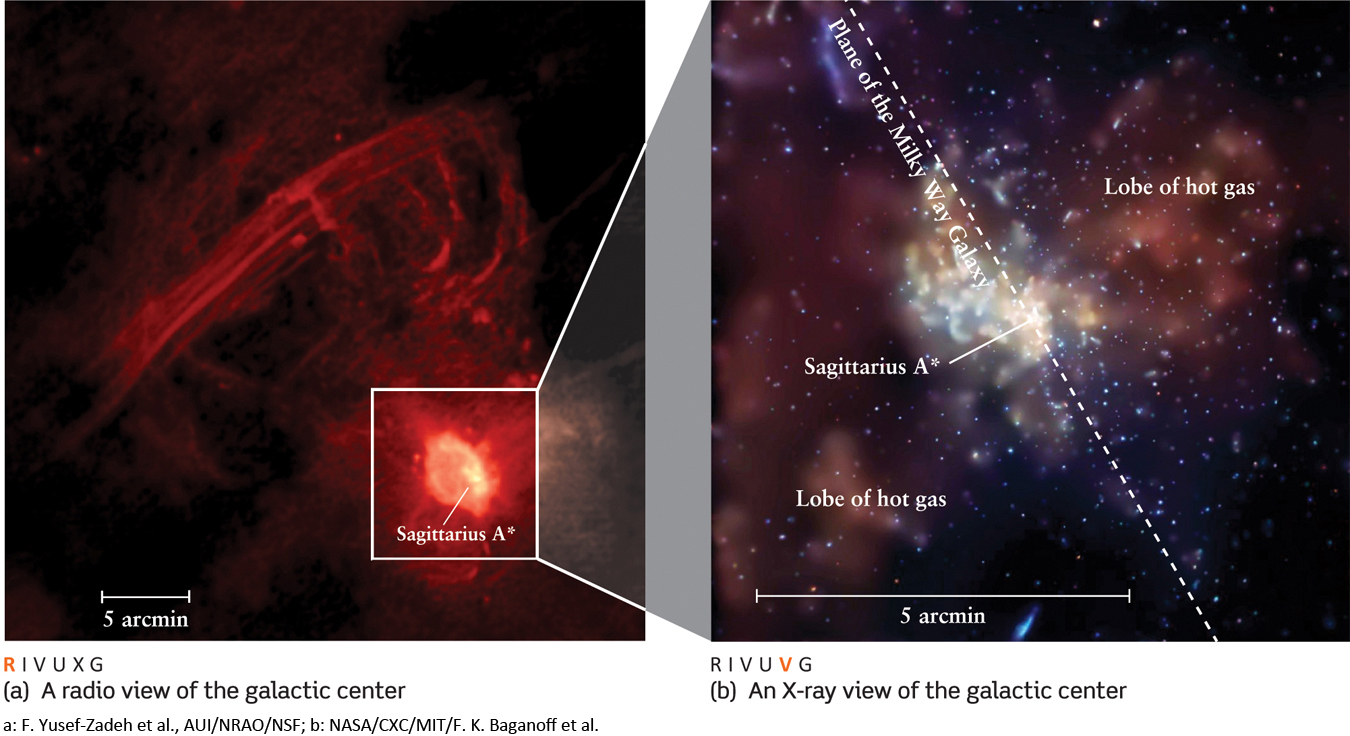13-6 Infrared and radio observations are used to probe the galactic nucleus
The innermost region of our Galaxy is an active, crowded place. If you lived on a planet near the galactic center, you would see a million stars as bright as Sirius, the brightest single star in our own night sky. The total intensity of starlight from all those nearby stars would be equivalent to 200 of our full moons. In effect, night would never really fall on a planet near the center of the Milky Way. At the center of this empire of light, however, lies the darkest of all objects in the universe—a black hole millions of times more massive than the Sun.
Sagittarius A*: Heart of Darkness
Because of the severe interstellar dust interference blocking visual wavelengths, most of our information about the galactic center comes from infrared and radio observations. Figure 13-26 shows three infrared views of the center of our Galaxy. Figure 13-26a is a wide-angle view covering a 50° segment of the Milky Way from Sagittarius through Scorpius. The prominent reddish band through the center of this false-color infrared image is a layer of dust in the plane of the Galaxy. Figure 13-26b is an infrared view of the galactic center. It is surrounded by numerous streamers of dust (shown in blue). The strongest infrared emission (shown in white) comes from a grouping of several powerful sources of radio waves. One of these sources, Sagittarius A* (say “A star”), lies at the very center of the Galaxy. (Its position, pinpointed with simultaneous observations by radio telescopes scattered around the world, seems to be very near the gravitational center of the Galaxy.) The high-resolution infrared view in Figure 13-26c shows hundreds of stars crowded within about 1 ly of Sagittarius A*. Compare this to our region of the Galaxy, where the average distance between stars is more than a light-year.

Sagittarius A* itself does not appear in infrared images. Nonetheless, astronomers have used infrared observations to make truly startling discoveries about this object. Since the 1990s, two research groups—one headed by Reinhard Genzel of the Max-Planck-Institute for Extraterrestrial Physics in Garching, Germany, and another led by Andrea Ghez at the University of California, Los Angeles—have been using infrared detectors to monitor the motions of stars in the immediate vicinity of Sagittarius A*. They have found a number of stars orbiting around Sagittarius A* (Figure 13-27) at speeds in excess of 3 million mi/h (1500 km/s). By comparison, Earth orbits the Sun at a lackadaisical 67,000 mi/h (30 km/s.) In 2000 the UCLA group observed one such star, called SO-16, as its elliptical orbit brought it within a mere 45 AU from Sagittarius A*—1½ times the distance from the Sun to Neptune. At its closest approach, SO-16 was traveling at a breathtaking speed of 27 million mi/h (12,000 km/s), which is about 4% of the speed of light!

321
In order to keep stars like SO-16 in such small, rapid orbits, Sagittarius A* must exert a powerful gravitational force and hence must be very massive. By applying Newton’s form of Kepler’s third law to the motions of these stars around Sagittarius A*, the UCLA group calculated the mass of Sagittarius A* to be a remarkable 3.7 million solar masses (3.7 × 106 M⊙). Furthermore, the small separation between SO-16 and Sagittarius A* at closest approach shows that Sagittarius A* can be no more than 45 AU in radius. An object this massive and this compact can only be one thing: a supermassive black hole.
Question
ConceptCheck 13-13: How would stars around Sagittarius A* be moving if a supermassive black hole were not found at the galactic center?
X-rays from Around a Supermassive Black Hole
Evidence in favor of this picture comes from the Chandra X-ray Observatory, which has observed X-ray flares coming from Sagittarius A*. The flares brighten dramatically over the space of just 10 minutes, which shows that the size of the flare’s source can be no larger than the distance that light travels in 10 minutes. In 10 minutes light travels a distance of about 100 million miles (1.8 × 108 km)—slightly more than the distance between the Sun and Earth—and only a black hole could pack a mass of 3.7 × 106 M⊙ into a volume size or smaller. The X-ray flares were presumably emitted by blobs of material that were compressed and heated as they fell into the black hole.
The X-ray flares from Sagittarius A* are relatively feeble, which suggests that the supermassive black hole is swallowing only relatively small amounts of material. But the region around Sagittarius A* is nonetheless an active and dynamic place. Figure 13-28a is a wide-angle radio image of the galactic center covering an area more than 60 pc (200 ly) across. Huge filaments of gas stretch for 65 ly northward of the galactic center (to the right and upward in Figure 13-28a) and then they abruptly arch southward (down and to the left in the figure). The orderly arrangement of these filaments is reminiscent of prominences on the Sun. This suggests that, as on the Sun, there is ionized gas at the galactic center that is being controlled by a powerful magnetic field. Indeed, much of the radio emission from the galactic center is radiation produced by high-energy electrons spiraling in a magnetic field.

A supermassive black hole exists at the center of the Milky Way as revealed by X-rays and rapid star movements.
322
The false-color X-ray image in Figure 13-28b shows the immediate vicinity of Sagittarius A*. The black hole is flanked by lobes of hot, ionized, X-ray–emitting gas that extend for dozens of light-years. These are thought to be the relics of immense explosions that may have taken place over the past several thousand years. Perhaps these past explosions cleared away much of the material around Sagittarius A*, leaving only small amounts to fall into the black hole. This could explain why the X-ray flares from Sagittarius A* are so weak.
There is nonetheless evidence that Sagittarius A* has been more active in the recent past. Between 2002 and 2005, Michael Muno and his colleagues at Caltech observed that certain nebulae that lie about 50 ly from Sagittarius A* suddenly became very bright at X-ray wavelengths. The character of the X-ray light was such that it could not have originated from the nebulae themselves. Muno and colleagues concluded that X-rays emitted from Sagittarius A* about 50 years earlier had struck and excited the nebulae, causing the nebulae to glow intensely at X-ray wavelengths. To produce such an intense X-ray glow, an object the size of the planet Mercury must have fallen into the supermassive black hole. The supermassive black hole at the center of our Galaxy is not unique. Observations show that such titanic black holes are a feature of most large galaxies.
Astronomers are still groping for a better understanding of the galactic center. With new technology, it may be possible to actually obtain a picture of the supermassive black hole lurking there. During the coming years, observations from Earth-orbiting satellites as well as from radio and infrared telescopes on the ground will certainly add to our knowledge of the core of the Milky Way.
Question
ConceptCheck 13-14: Why would the brightening of a nebula near the galactic center suggest the presence of a supermassive black hole?